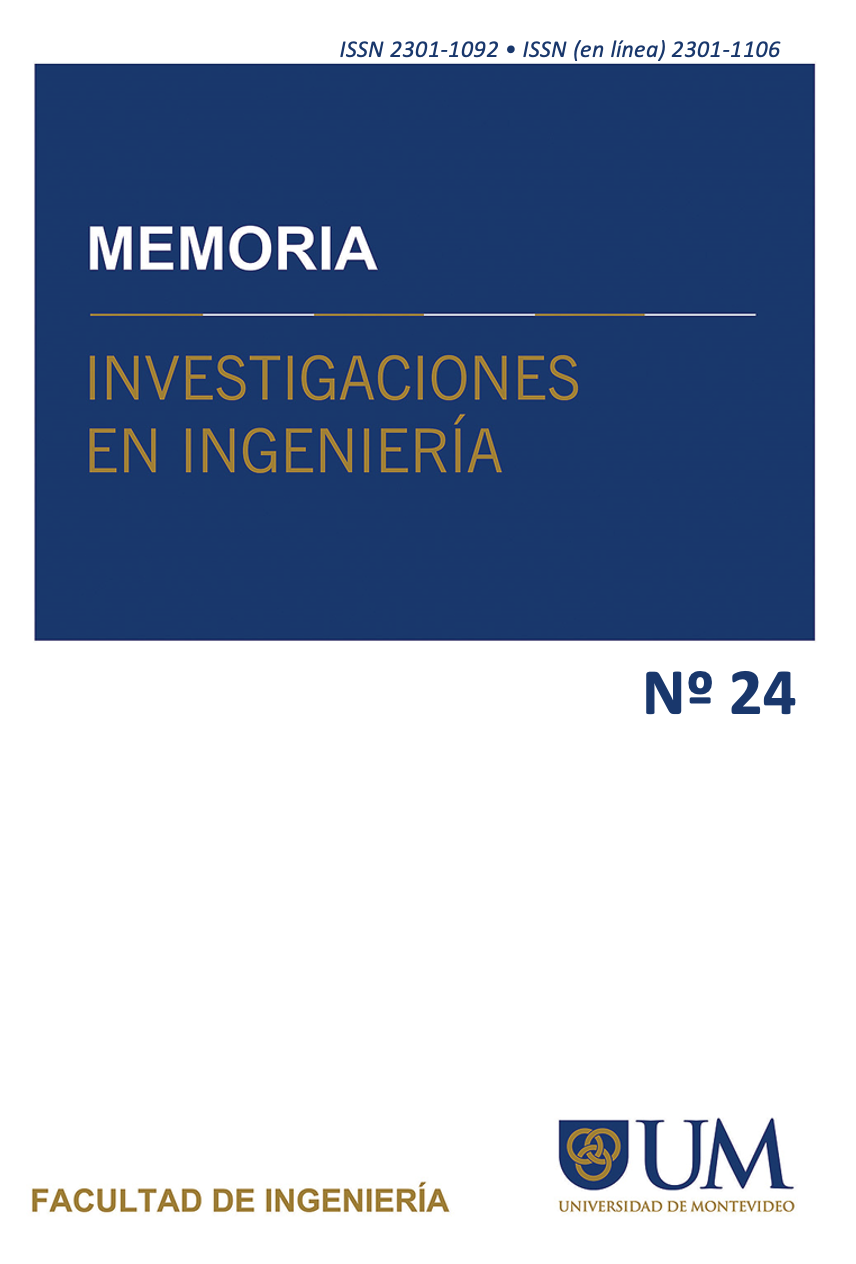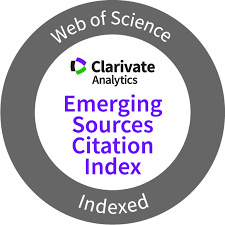Avaliação de risco de árvores urbanas usando tecnologias não destrutivas
DOI:
https://doi.org/10.36561/ING.24.13Palavras-chave:
Arboricultura, Clasificação de risco das árvores, Árvores urbanas, Árvore perigosa, Floresta urbanaResumo
As árvores urbanas fornecem serviços ecossistêmicos de grande importância para a cidade. Para usufruir destes serviços, é importante que as árvores se encontrem em bom estado, minimizando o risco para pessoas, bens e atividades essenciais devido à queda de ramos ou árvores inteiras. Portanto, sua condição deve ser devidamente avaliada para favorecer sua presença na cidade com níveis aceitáveis de risco. O principal objetivo desta pesquisa foi comparar avaliações de probabilidade de falha de árvores urbanas usando três níveis de avaliação de risco, bem como estudar a combinação de avaliação visual com resultados obtidos de tecnologias não destrutivas. Foram avaliadas 32 árvores dos gêneros Eucalyptus e Tipuana, localizadas em um parque urbano em Montevidéu, Uruguai. Dois avaliadores com experiência em avaliação visual e equipamentos não destrutivos utilizaram três níveis de avaliação de acordo com ANSI A300. Para os níveis 1 e 2, foram utilizados descritores baseados no método ISA/BMP. Para o nível 3, as avaliações foram realizadas com um equipamento de resistência à perfuração e um tomógrafo acústico. As avaliações visuais básicas e as análises não destrutivas puderam ser vinculadas, principalmente em árvores que apresentavam alguma evidência de problemas estruturais nos fustes.
Downloads
Referências
Nowak DJ, Crane DE, Stevens JC. 2006. Air pollution removal by urban trees and shrubs in the United States. Urban Forestry & Urban Greening, 4: 115-123. https://doi.org/10.1016/j.ufug.2006.01.007.
Hernández HJ. 2008. La situación del arbolado urbano en Santiago. Revista de Urbanismo, 18: 1-8. https://doi.org/10.5354/0717-5051.2010.272.
Haase D, Larondelle N, Andersson E, Artmann M, Borgström S, Breuste J, Gomez-Baggethun E, Gren Å, Hamstead Z, Hansen R, Kabisch N, Kremer P, Langemeyer J, Rall EL, McPhearson T, Pauleit S, Qureshi S, Schwarz N, Voigt A, Wurster D, Elmqvist T. 2014. A quantitative review of urban ecosystem service assessments: Concepts, models, and implementation. AMBIO, 43: 413-433. https://doi.org/10.1007/s13280-014-0504-0.
Hamstead ZA, Kremer P, Larondelle N, McPhearson T, Haase D. 2016. Classification of the heterogeneous structure of urban landscapes (STURLA) as an indicator of landscape function applied to surface temperature in New York City. Ecological Indicators, 70: 574-585. https://doi.org/10.1016/j.ecolind.2015.10.014.
Ponce-Donoso M, Vallejos-Barra O, Ingram B, Daniluk-Mosquera G. 2020. Urban Trees and Environmental Variables: Relationships in a City of Central Chile. Arboriculture & Urban Forestry, 46(2): 84-95.
National Tree Safety Group. 2011. Common sense risk management of trees: Guidance on trees and public safety in the UK for owners, managers and advisers. Forestry Commission. Edinburgh: Forestry Commission. 104 p.
Vogt J, Hauer RJ, Fischer BC. 2015. The Costs of Maintaining and Not Maintaining the Urban Forest: A Review of the Urban Forestry and Arboriculture Literature. 41(6): 293-323.
Calaza P, Iglesias I. 2016. El riesgo del arbolado urbano. Contexto, concepto y evolución. Madrid: Mundi-Prensa. 526 p.
van Wassenaer P, Richardson M. 2009. A review of tree risk assessment using minimally invasive technologies and two case studies. Arboricultural Journal, 32(4): 275-292. https://doi.org/10.1080/03071375.2009.9747583.
Tomao A, Secondi L, Corona P, Giuliarelli D, Quatrini V, Agrimi M. 2015. Can composite indices explain multidimensionality of tree risk assessment? A case study in an historical monumental complex. Urban Forestry & Urban Greening, 14(3): 456-465. https://doi.org/10.1016/j.ufug.2015.04.009.
American National Standards Institute. (2011). ANSI A300 (Part 9)—Tree Risk Assessment a. Tree Failure. American National Standards Institute.
Pokorny, J. D. (2003). Urban Tree Risk Management: A Community Guide to Program Design and Implementation. USDA Forest Service, Northeastern Area, State and Private Forestry. https://www.fs.usda.gov/naspf/publications/urban-tree-risk-management-community-guide-program-design-and-implementation
Wessolly, L., & Erb, M. (2016). Manual of Tree Statics and Tree Inspection. Patzer Verlag.
Okun, A., Brazee, N.J., Clark, J.R., Cunningham-Minnick, M.J. Burcham, D.C., Kane, B. 2023. Assessing the Likelihood of Failure Due to Stem Decay Using Different Assessment Techniques. Forests, 14, 1043. https://doi.org/10.3390/f14051043.
Johnstone, D., Ades, P., Moore, G., & Smith, I. (2007). Predicting Wood Decay in Eucalypts Using an Expert System and the IML-Resistograph Drill. Arboriculture & Urban Forestry, 33(2), 76-82. https://doi.org/10.48044/jauf.2007.009
Ciftci, C., Kane, B., Brena, S. F., & Arwade, S. R. (2014). Loss in moment capacity of tree stems induced by decay. Trees, 28(2), 517-529. https://doi.org/10.1007/s00468-013-0968-8
Lin, C.-J., Lee, C.-J., & Tsai, M.-J. (2016). Inspection and Evaluation of Decay Damage in Japanese Cedar Trees Through Nondestructive Techniques. Arboriculture & Urban Forestry, 42(3). https://doi.org/10.48044/jauf.2016.018
Wu, X., Li, G., Jiao, Z., & Wang, X. (2018). Reliability of acoustic tomography and ground-penetrating radar for tree decay detection. Applications in Plant Sciences, 6(10), 8. ht tps://doi.org/10.1002/aps3.1187
Burcham, D. C. (2019). Can sonic tomography predict loss in load-bearing capacity for trees with internal defects? A comparison of sonic tomograms with destructive measurements. 15.
Wang, X., & Allison, R. B. (2008). Decay Detection in Red Oak Trees Using a Combination of Visual Inspection, Acoustic Testing, and Resistance Microdrilling. Arboriculture & Urban Forestry, 34(1), 4.
Guo, L., Chen, J., Cui, X., Fan, B., & Lin, H. (2013). Application of ground penetrating radar for coarse root detection and quantification: A review. Plant Soil, 362, 1-23. https://doi.org/10.1007/s11104-012-1455-5
Koeser, A. K., Hauer, R. J., Klein, R. W., & Miesbauer, J. W. (2017). Assessment of likelihood of failure using limited visual, basic, and advanced assessment techniques. Urban Forestry & Urban Greening, 24, 71-79. https://doi.org/10.1016/j.ufug.2017.03.024
Nicolotti, G., Socco, L. V., Martinis, R., Godio, A., & Sambuelli, L. (2003). Application and comparison of three tomographic techniques for detection of decay in trees. Journal of Arboriculture, 29(2), 66-78.
Rust, S. 2017. Accuracy and Reproducibility of Acoustic Tomography Significantly Increase with Precision of Sensor Position. Journal of Forest and Landscape Research, 1 (2017): 1–6. DOI: 10.13141/jflr.v2i1.449
Instituto Uruguayo de Meteorología. 2020. Estadísticas climatológicas [En línea]. 31 agosto 2020. https://www.inumet.gub.uy/index.php/clima/estadisticas-climatologicas.
Dunster, J. A., Smiley, E. T., Matheny, N., & Lilly, S. (2017). Tree Risk Assessment Manual (2a ed). International Society of Arboriculture.
Di Rienzo JA, Casanoves F, Balzarini MG, Gonzalez L, Tablada M, CW Robledo. 2020. InfoStat versión 2020. Centro de Transferencia InfoStat, FCA, Universidad Nacional de Córdoba, Argentina [En línea]. 23 marzo 2020. http://www.infostat.com.ar.
Rinn, F. (2012). ARBOTOM User Manual. Rinntech.
Koeser, A. K., Hasing, G., McLean, D., & Northrop, R. (2016). Tree Risk Assessment Methods: A Comparison of Three Common Evaluation Forms. Environmental Horticulture Department, UF/IFAS Extension, 8.
Boland, D., Brooker, M., Chippendale, G., Hall, N., Hyland, B., Johnston, R., Kleinig, D., McDonald, M., & Turner, J. (2006). Forest Trees of Australia (5.a ed.). CSIRO Publishing. https://doi.org/10.1071/9780643069701
Tortorelli, L. A. (2009). Maderas y bosques argentinos (2a, Vol. 1). Orientación Gráfica Editora.
Rollo, F. (2010). Identificação de padrões de resposta à tomografia de impulso em tipuanas (Tipuana tipu (Benth.) O. Kuntze [Mestrado em Recursos Florestais, Universidade de São Paulo]. https://doi.org/10.11606/D.11.2010.tde-16032010-142305
Cheng-Jung, L., Chia-Ju, L. & Ming-Jer, T. 2016. Inspection and Evaluation of Decay Damage in Japanese Cedar Trees Through Nondestructive Techniques. Arboriculture & Urban Forestry. 42(3), 201–212.
Publicado
Como Citar
Edição
Seção
Licença
Copyright (c) 2023 Ana Paula Coelho-Duarte, Oscar Vallejos-Barra, Mauricio Ponce-Donoso

Este trabalho está licenciado sob uma licença Creative Commons Attribution 4.0 International License.






















